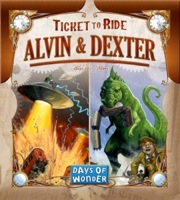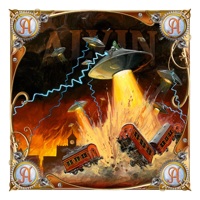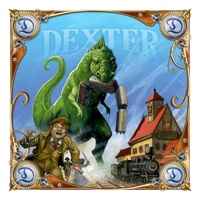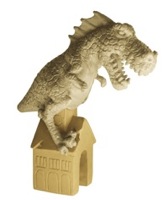
|
About OgreCave and its staff
|

|
by Lee Valentine
Alvin & Dexter (A&D) is the newest Ticket to Ride (TTR) expansion. It is a set of two plastic figures, one a Godzilla-styled dinosaur called "Dexter" and one an alien with a spaceship called "Alvin". They are usable with any TTR board game set, and they sow chaos across the board in the cities they pass through. Originally envisioned as a Godzilla variant for a Japanese version of TTR that never came to pass, TTR-designer Alan Moon did some additional work on the concept, added an alien, and brought the world A&D.
Gameplay
During the game, while a monster is at a given city you can't build depots (TTR: Europa 1912), move passengers through the city (TTR: Marklin), or build stations there (TTR: Europe). Also, you can lay down trains on a new route if either of the end points have a monster on them. These cities are "cities in chaos". At the end of the game if you have any destination tickets and either end point is a "city in chaos" the ticket is worth only half the normal number of points for you (if you complete it) or against you (if you failed to complete it). If you are playing a TTR edition that has long route destination tickets, toward the end of the game players will probably drive the monsters to the end points of one of those routes to try to cost an opponent as many points as possible. During the game, they can be easily used to hound an opponent by merely sitting on the last city he built a route to, as many players build their routes sequentially.
The dual use of locomotives both as wildcards and as movement cards for the monsters in A&D will make claiming tunnels (in TTR: Switzerland and TTR: Nordic Countries) more difficult. The demand for locomotives can be at such a premium that claiming ferry routes (in TTR: Nordic Countries and TTR: Europe) will be difficult or impossible if you are also trying to compete for the 30 monster bonus points available, since ferry routes require you to play locomotives to claim them. Given this prejudice against ferry routes, A&D can be somewhat disruptive to the normal play experience in TTR: Europe and probably for TTR: Nordic Countries as well. Entire sections of the TTR: Europe game board, for example, become undesirable to choose as tickets. If you get a handful of them, you'll either have to complete the route or control the monsters, but you probably won't be able to do both very well. This will be even more true when playing with three to five players because the locomotives will be spread out a bit thinner among all the players, and they will be getting selected more often than in normal TTR: Europe. I suspect that the best set to use A&D with is the base TTR board, and ideally with the USA 1910 expansion cards. The "Big Cities" variant in the USA 1910 expansion would provide interesting strategic options for using the monsters, without the prejudice against ferries and tunnels (since there aren't either one of these on the USA board). Even without the USA 1910 expansion, this will be a nice addition to the base TTR board, particularly for two players.
Even with two players, while the A&D expansion adds a new, interesting layer of strategy, it also adds a lot of chaos. Given that the mechanic is locomotive card driven, it's entirely possible that I draw substantially more locomotives than you, and get an easy 30 points, controlling both monsters. Indeed, that is exactly what happened in one game we played. This expansion has another odd side effect when played with TTR versions where drawing a face-up locomotive costs you both of your draws – you may avoid drawing face up trains if you can, particularly in two-player play. Since many players will want every locomotive they can get their hands on, if you draw a normal train from the face up stack then there's a chance that it will get replaced by a locomotive which your opponent will acquire for himself. While this is not enough to stifle taking face up cards altogether, it changes the normal balance of power between face up draws and blind draws from the train deck sufficiently that drawing blind will become substantially more useful than normal.
Components
The packaging itself is very colorful, and shows whimsical, full-color art of the monsters attacking trains. The plastic insert that holds the creatures will likely make sure that your monsters arrive to you intact. Unfortunately, the insert grips the figures a bit too tightly, and it can be troublesome to extract the miniatures. As a result, the packaging is sub-optimal for storing the miniatures if you intend on using this expansion regularly. Thankfully, the contents of the expansion are small enough to fit inside a typical TTR game box if you choose not to store the expansion separately. The rulebook is largely clear. Like the rest of the expansion, it is quite tiny. The text is brief, and is available in a variety of European languages. Unfortunately, Alan Moon did not directly address how Alvin & Dexter interacts with depots, stations, and passengers, in the various TTR game editions. Given that this expansion was intended to work with all TTR editions, this is a substantial oversight. Nevertheless, Moon has provided guidance on this in online forums, stating that the monsters do not destroy pre-existing depots, stations, and passengers, but the monsters do prevent any new structures from being built in "cities in chaos". Passengers similarly cannot travel through such cities.
Conclusions
For Retailers
Lee's Ratings:
Links
|
||||
 Alvin & Dexter - A Ticket to Ride Monster expansion
Alvin & Dexter - A Ticket to Ride Monster expansion There are two decks of small cards marked "Alvin" and "Dexter"
respectively. You collect the appropriate card when you move a monster.
Until the end of your next turn neither you nor any other player may
move that monster. At the end of the game you count how many "Alvin"
and "Dexter" cards you have, separating each type. The player with the
most cards of a given type at the end of the game scores a 15-point
bonus. Tied players each get the bonus. So, Alvin and Dexter can
collectively contribute a 30-point swing to the game, giving you an
enormous incentive to pay attention to them, particularly in TTR
variants that lack long route destination tickets to drive the score up.
There are two decks of small cards marked "Alvin" and "Dexter"
respectively. You collect the appropriate card when you move a monster.
Until the end of your next turn neither you nor any other player may
move that monster. At the end of the game you count how many "Alvin"
and "Dexter" cards you have, separating each type. The player with the
most cards of a given type at the end of the game scores a 15-point
bonus. Tied players each get the bonus. So, Alvin and Dexter can
collectively contribute a 30-point swing to the game, giving you an
enormous incentive to pay attention to them, particularly in TTR
variants that lack long route destination tickets to drive the score up.
 In TTR and TTR: Europe picking a face up locomotive costs
you both your draws for the turn. Still, you will make this sacrifice
frequently because of the in game incentives to do so while playing with
A&D. Since the locomotives in TTR: Switzerland, TTR: Nordic
Countries, and to a lesser extent in TTR: Marklin (with its
special +4 locomotives) all cost you only a single draw, picking up
these cards will become an automatic reflex.
In TTR and TTR: Europe picking a face up locomotive costs
you both your draws for the turn. Still, you will make this sacrifice
frequently because of the in game incentives to do so while playing with
A&D. Since the locomotives in TTR: Switzerland, TTR: Nordic
Countries, and to a lesser extent in TTR: Marklin (with its
special +4 locomotives) all cost you only a single draw, picking up
these cards will become an automatic reflex.
 With more than two players A&D introduces an obvious strategy
that is difficult to employ in a normal TTR game: all the other
players can gang up on the scoring leader. Consider that, in a
five-player game, the locomotives are split five ways. The score leader
will, on average, have only 1/5 of the overall locomotives, and can be
easily hounded by the monsters if the other players agree to gang up on
him. Even without this expansion it is possible to collude against the
leader, but it is a trivial undertaking to do so with this expansion, as
it only minimally interferes with your own turns.
With more than two players A&D introduces an obvious strategy
that is difficult to employ in a normal TTR game: all the other
players can gang up on the scoring leader. Consider that, in a
five-player game, the locomotives are split five ways. The score leader
will, on average, have only 1/5 of the overall locomotives, and can be
easily hounded by the monsters if the other players agree to gang up on
him. Even without this expansion it is possible to collude against the
leader, but it is a trivial undertaking to do so with this expansion, as
it only minimally interferes with your own turns.
 The cards that come with the game are small, square cards. They are
full-color and have a nice linen finish. They are handled only
minimally during play, so they will see little wear during use.
The cards that come with the game are small, square cards. They are
full-color and have a nice linen finish. They are handled only
minimally during play, so they will see little wear during use.